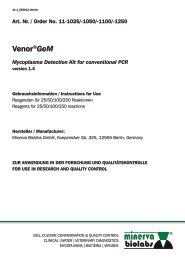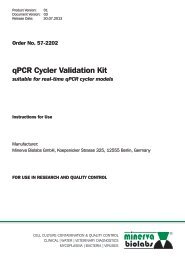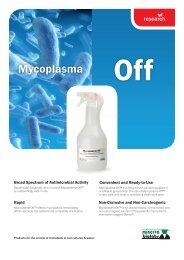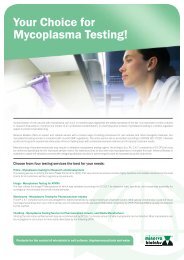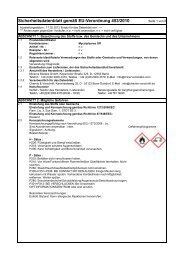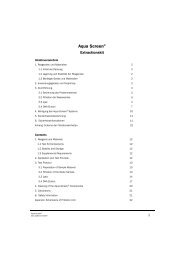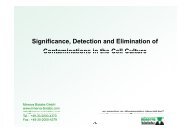Mycoplasma Contaminations in the Cell Culture ... - Minerva Biolabs
Mycoplasma Contaminations in the Cell Culture ... - Minerva Biolabs
Mycoplasma Contaminations in the Cell Culture ... - Minerva Biolabs
You also want an ePaper? Increase the reach of your titles
YUMPU automatically turns print PDFs into web optimized ePapers that Google loves.
<strong>Mycoplasma</strong> (cont<strong>in</strong>ued)<br />
• Pass cellulose- and polyv<strong>in</strong>yl filter with 0,45 µm pore width<br />
• Smalles, self-replicat<strong>in</strong>g organisms (0,3 to 0,8 µm, 600 kb to 1700 kb (1/5 of<br />
E. coli-genome) with approx. 500 genes<br />
• Need to consume cholesterol, l am<strong>in</strong>o acids, fatty acids, vitam<strong>in</strong>s i and o<strong>the</strong>r<br />
catabolites<br />
• Typically arg<strong>in</strong><strong>in</strong>e, glucose or urea metabolism<br />
• Lacks cell wall, but has simple plasma membrane<br />
– extremely flexible <strong>in</strong> relation to environment, however sensitive <strong>in</strong> relation to<br />
chemical <strong>in</strong>fluences<br />
– resistant to penicill<strong>in</strong>, conta<strong>in</strong>s no peptido p glycan gy wall<br />
– osmotically unstable<br />
• Occurr<strong>in</strong>g extra cellularly, only <strong>in</strong> rare cases <strong>in</strong>tracellularly



